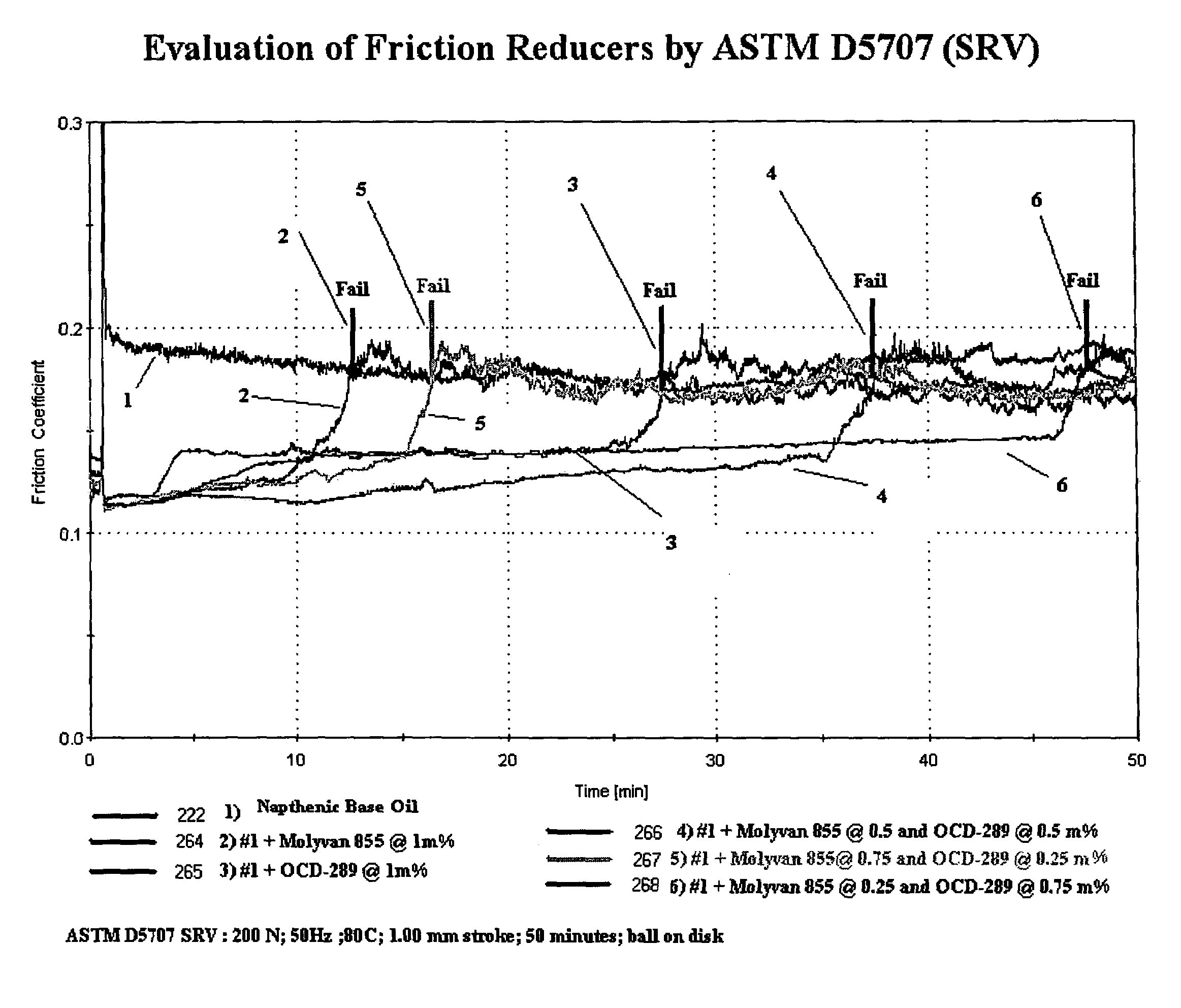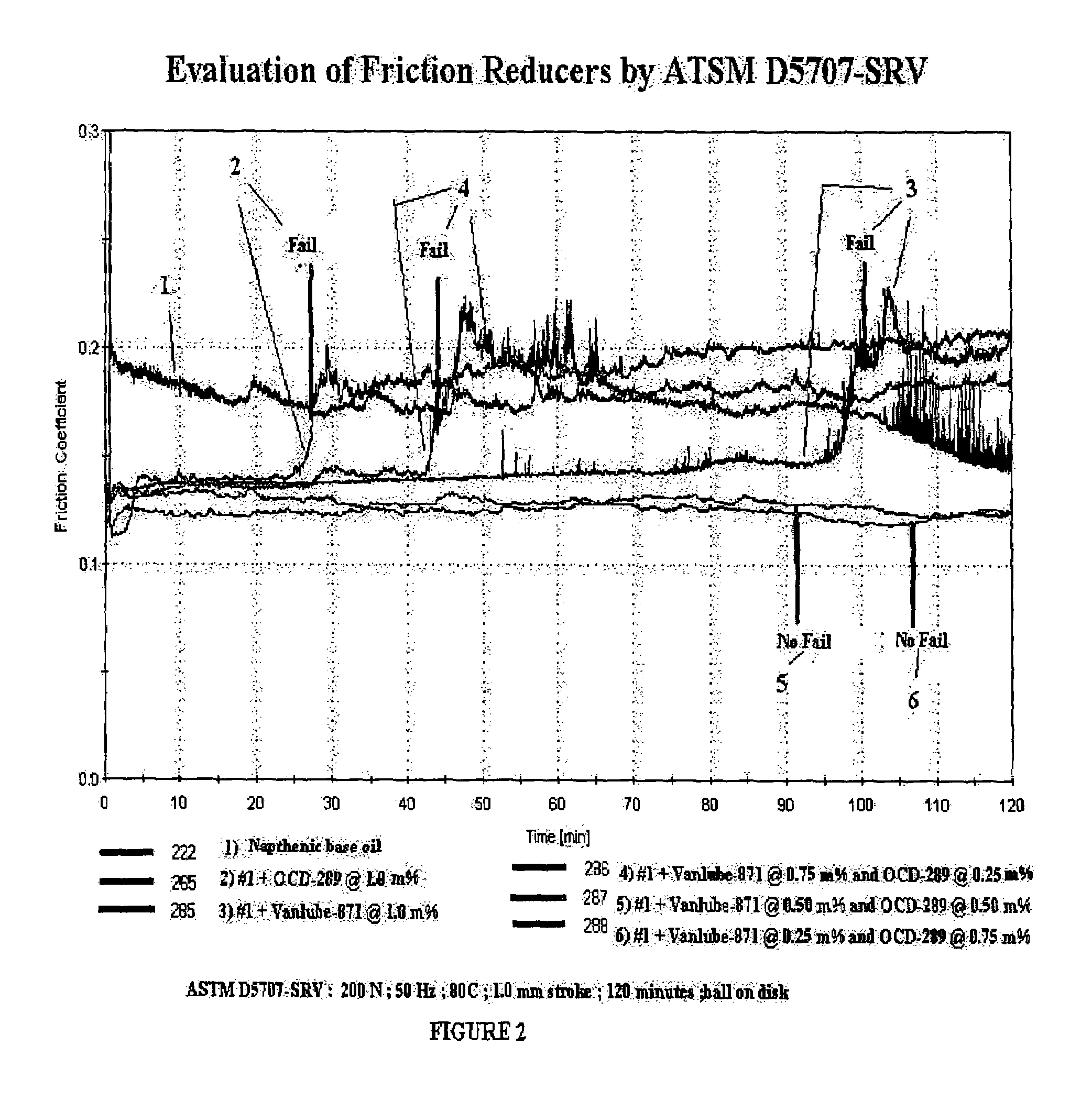Synergistic organoborate compositions and lubricating compositions containing same
a technology of organoborate composition and lubricating composition, which is applied in the field of lubricating compositions, can solve the problems of unsuitable formulation for the new gf-4 requirements, insufficient anti-wear protection in the oil at a reasonable cost, etc., and achieve the effect of improving lubricating properties
- Summary
- Abstract
- Description
- Claims
- Application Information
AI Technical Summary
Benefits of technology
Problems solved by technology
Method used
Image
Examples
example 1a
Preparation of OCD-289 Borated Diol Mixture
[0119]OCD-289 Borated Diol (organo borate ester composition) mixture is made by partially borating a mixture of [C8-18 fatty acid residue] diethanol amide (75%) and [C8-18 fatty acid residue] monoglyceride (22%), borated to a level of 1%. This level of boration affords motor oil solubility. The Example 1 formulation is the basis of the testing in Tables 1 and 2 below.
Preparation:
[0120]1. To a 500 ml one neck flask, 14.3 g. of boric acid and 247.5 g. of OD-896 were added. OD-896 is the reaction product of a fatty oil with diethanolamine, and is available from R.T. Vanderbilt Company, Inc.[0121]2. Attached the flask to a vacuum evaporator and started rotating at moderate speed at room temperature until boric acid became uniformly dispersed in OD-896.[0122]3. Applied vacuum onto the flask to remove entrapped air from the mixture.[0123]4. Gradually heated the mixture to 65 C. for 1 hour to remove initial water.[0124]5. Continued heating the mix...
example 1b
Preparation of OCD-289 (Neat, 1% Boron) Butanol Process
Preparation:
[0126]1. To a 500 ml 3-neck flask, 5.78 g. of boric acid, 100.0 g. of OD-896NT and 40.0 g. butanol were added.[0127]2. Turned on an agitator and mixed at moderately high speed until boric acid was uniformly dispersed in the OD-896NT / butanol solution.[0128]3. Gradually heated the mixture to 95 C. for 3 hours to remove initial water.[0129]4. Continued heating the mixture to a reflux temperature at 130 C. for 3 hours to remove residual water.[0130]5. Increased the temperature to 150 C. and applied vacuum onto the flask for 2 hours to remove residual butanol.[0131]6. Filtered the product at 110 C. before packaging.
example 1c
Preparation of OCD 289
[0132]1. To a 2 liter three neck round-bottomed flask was added 1103.0 g of OD 896 and 71.05 g of boric acid. OD 289 is the reaction product of a fatty oil with a diethanolamine, and is available from R.T. Vanderbilt Company, Inc.
[0133]2. The flask was equipped with a Dean Stark Trap, condenser, thermometer and a mechanical stirrer.
[0134]3. The entire apparatus was placed under approximately 50 mm Hg pressure, and heated to 130 C.
[0135]4. Water was collected over a period of between 5-7 hours at 130 C.
[0136]5. The reaction was cooled to about 80 C, and 123.5 g of napthenic base oil was added while stirring, then filtered while still warm to give a yellow liquid.
PUM
| Property | Measurement | Unit |
|---|---|---|
| mass % | aaaaa | aaaaa |
| mass percent | aaaaa | aaaaa |
| mass | aaaaa | aaaaa |
Abstract
Description
Claims
Application Information
 Login to View More
Login to View More - R&D
- Intellectual Property
- Life Sciences
- Materials
- Tech Scout
- Unparalleled Data Quality
- Higher Quality Content
- 60% Fewer Hallucinations
Browse by: Latest US Patents, China's latest patents, Technical Efficacy Thesaurus, Application Domain, Technology Topic, Popular Technical Reports.
© 2025 PatSnap. All rights reserved.Legal|Privacy policy|Modern Slavery Act Transparency Statement|Sitemap|About US| Contact US: help@patsnap.com



